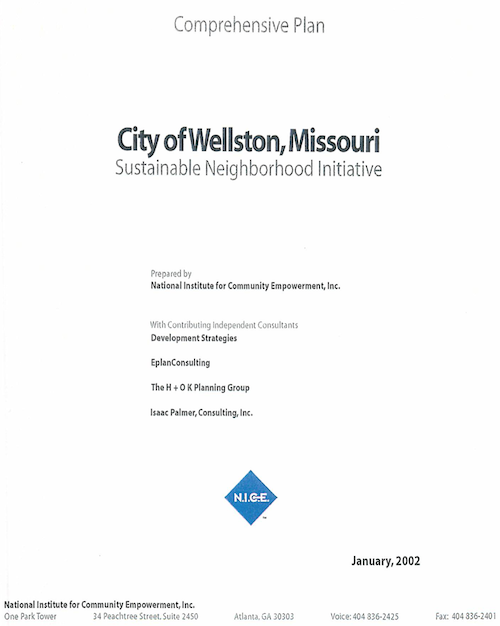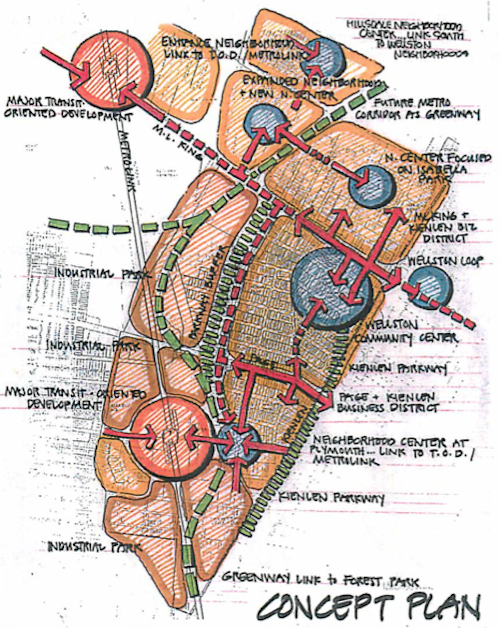Wellston’s 2002 Sustainable Neighborhood Initiative
In October I posted about the New Wellston Child Care Center Under Construction, Adjacent To MetroLink Station, and noted promotional materials referenced compliance with the Wellston Sustainable Neighborhood Initiative. I wanted to see this initiative to see how the new construction complies, if it all. After a few emails I received a copy of the initiative — it had to be scanned! The initiative process started in 1998, the final document was from January 2002.

The goals detailed were:
- Raise the incomes of Wellston’s residents.
- Improve the system of education in Wellston.
- Improve the quality of Wellston’s neighborhoods.
- Establish a central destination place in Wellston.
- Improve access to employment, goods, and services for Wellston’s residents.
- Improve the health and well being of Wellston’s citizens.
- Enhance the image of Wellston and pride its citizens hold about their community.
- Stimulate local economic growth.
- Increase the social capital and improve the community capacity in Wellston.
- Revitalize the MLK Corridor.
It’s hard to know how well Wellston has done with many of the above, however, the early development child care center now under construction should pay future dividends with respect to education, and eventually incomes.

The report was prepared by The National Institute for Community Empowerment, Inc., which no longer seems to exist. I couldn’t find a website and their last phone number is not in service. A local contributor was the Regional Housing and Community Development Alliance (RHCDA), rebranded this year as Rise. Area Resources for Community and Human Services (ARCHES‘) is still around as well.
I’ve been looking through the report for the last month, developing questions to ask about the progress that’s been made in the last dozen years. The most obvious are measurable results toward the ten goals listed above. Do they consider a recent Family Dollar store and a gas station as having met #10, revitalizing the MLK corridor? Any positive gains in education? Given the Wellston School District shut down in 2010 and unaccredited Normandy School District struggles, I rather doubt there’s good news to report.
The new Wellston Early Childhood Center will open in the fall of 2014, not a moment too soon.
— Steve Patterson
Wellston is a St. Louis County place that might fare better under a “Better Together” merger/consolidation scenario. Local government there is completely broken.
Leaders in small towns, including Wellston, are afraid of giving up power and identity. Leaders in larger towns look at ‘what’s it going to cost us’, and are afraid to dilute their power, money, voter base. Not to mention social, economic, and racial prejudice going both ways. Who’s caught in the middle: the voters/residents. The region as a whole is nary a thought.
This isn’t the Better Together thread, but if I’m advising the BT people, I’d be looking for more Wellstons (much of North County?) where the County folk can see how through merger/consolidation, they can share the burden of supporting those challenged areas with their neighbors, and then overall highlight fewer city landmarks and more County ones to get County folk to see that they are valued in the region for their amenities (not just their tax base), and that they are not just living off the milk of the city’s assets without having to buy the cow (city) through some kind of merger. I also think getting too many political types in the front of this bus is a huge risk.
That’s good news that something is finally going in next to the station. Wellston has some of the only land (empty fields!) well suited for major TOD. Were it not such a blighted “scary” place, these would’ve been developed years ago. I’m glad to hear that the city government embraces this (at least in theory). I took some time and marked off the empty lots prime for TOD (green) within a 1/4 mile comfortable walking-distance (gold) of the two Metrolink stations.
I agree with those below that state that Wellston’s problems can’t be solved by the city alone. They are largely the victim of regional issues such as racial/economic segregation that should be addressed at the regional level.